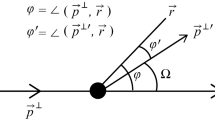Summary
We report a remarkable phenomenon in the relativistic classical scattering of two particles having both electric and magnetic charges, which is not present in the ordinary scattering of two singly charged particles,i.e. the occurrence of infinitely many singularities in the differential cross-section. These singularities correspond to compound states formed by the scattered particle makingn loops,n=0,1,2,3,..., around the scattering centre; their positions are given by eq. (3.21) for the particular case studied.
Riassunto
Si riferisce su un notevole fenomeno nello scattering classico relativistico di due particelle dotate sia di carica elettrica che di carica magnetica, che non si manifesta nello scattering ordinario di due particelle dotate di un solo tipo di carica, cioè la presenza di una infinità di singolarità nella sezione d'urto differenziale. Tali singolarità corrispondono a stati composti formati dalla particella che viene diffusa descrivendon cappi,n=0,1,2,3,..., attorno al centro di scattering; le posizioni delle singolarità si determinano mediante l'equazione (3.21), per il particolare caso studiato.
резюме
Мы указываем на интересное явление в релятивистском классическом рассеянии двух частиц, имеющих и электрический и магнитный заряды, которое отсутствует при обычном рассеянии двух частиц, имеющих единственный заряд. Явление состоит в появлении бесконечно большого числа синтулярностей в дифференциальном поперечном сечении. Эти сингулярности соответствуют составным состояниям, образованным рассеянной частицей, которая совершаетn петель,n=0, 1,2,3,..., вокруг рассеивающего центра. Для рассмотренного случая приводятся положения синтулярностей.
Similar content being viewed by others
References
N. Cabibbo andE. Ferrari:Nuovo Cimento,23, 1147 (1962).
J. Schwinger:a)Phys. Rev.,144, 1087 (1966);b), Phys. Rev.,151, 1048 (1966);c) Phys. Rev.,173, 1536 (1969).
G. Wentzel:Progr. Theor. Phys. Suppl.,37–38, 163 (1966).
D. Zwanziger:Phys. Rev.,176, 1480 (1968).
A. O. Barut:Phys. Rev. D,3, 1747 (1971).
A. O. Barut andG. Bornzin:Journ. Math. Phys.,12, 841 (1971).
A. Goldhaber:Phys. Rev.,140, 1407 (1965).
K. Rzązewski:Acta Phys. Polon., B2, 707 (1971) (for classical bound-state solutions).
I. Bialynicki-Birula:Phys. Rev. D,3, 2413 (1971).
Author information
Authors and Affiliations
Additional information
Supported in part by the Air Force Office of Scientific Research.
Traduzione a cura della Redazione.
Переведено редакцией.
Rights and permissions
About this article
Cite this article
Barut, A.O., Beker, H. Classical relativistic scattering of two dyons. Nuov Cim A 19, 309–323 (1974). https://doi.org/10.1007/BF02801855
Received:
Published:
Issue Date:
DOI: https://doi.org/10.1007/BF02801855



